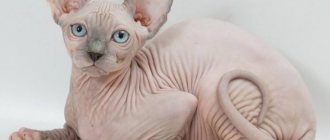In order for a pregnant Sphynx cat to be able to bear offspring normally and give birth to kittens on time, it is important not to rush into mating and wait until the animal reaches full physical maturity, which does not occur earlier than 12-14 months. Don, Canadian Sphynxes and the Peterbald variety become sexually mature at the age of 6-9 months. But early pregnancy in cats can negatively affect the health of mother and babies. Therefore, it is better to wait until the cat grows up, and only then introduce her to her gentleman.
Everything you need to know about breeding the Canadian Sphynx
Absolutely every owner of a Sphynx cat sooner or later must decide for himself whether his four-legged friend needs mating.
If you still decide that you need Sphynx kittens, then you definitely need to know when and how to properly breed your pet. In order to organize this very complex process correctly, every owner of a Canadian Sphynx must understand how puberty occurs in cats of this breed. After all, such knowledge will help the animal owner determine whether the pet is ready for mating or not.
False and frozen pregnancy: diagnosis and treatment
| Types of pathologies | Causes of the pathological condition | Diagnostic methods | Treatment options |
| False (imaginary) pregnancy |
|
| Low-calorie diet, therapy aimed at normalizing the production of sex hormones or sterilization. |
| Frozen pregnancy |
| If not all embryos die, the pregnancy continues. Dead fetuses are released during the birth process along with the living ones. If not a single embryo survives, a miscarriage is expected or labor is induced with medication. After birth, the cat is examined to assess the cleanliness of the uterus. Often an animal that has suffered a frozen pregnancy is sterilized. |
What you need to know about Sphynx pregnancy?
Mating of Sphynxes is almost no different from mating of individuals of any other breed. There are no peculiarities in the course of pregnancy either. There are only some differences in puberty and preparation for mating.
Puberty
Individuals of the Sphynx breed become sexually mature early. The first estrus begins already at 6–7 months of age. The behavior of a young female changes; she may become more affectionate or, conversely, more irritable.
But you need to understand that puberty does not mean the animal’s body is ready to mate. It is strictly forbidden to breed a female during her first heat, since there is a high probability of difficult childbirth and the birth of non-viable offspring.
Males become sexually mature later than females, at 8–9 months of age. The character of a young Sphynx cat also changes, becoming more arrogant and aggressive. The male begins to mark the territory. But you shouldn’t breed a cat, like a cat, too early; his body is not yet ready for mating.
Ready for mating
A female can become pregnant after her second or third heat. The optimal age for the first mating is 1.5 or 2 years, when the sphinx’s body is formed and the reproductive system is ready to work fully.
Basic rule of knitting
First of all, every breeder must know that it is impossible to abuse various drugs that suppress or stop estrus in cats.
After all, excessive use of these drugs can lead not only to hormonal disruption in the body of cats, but also cause very serious diseases.
And that is why every owner must decide whether he needs to breed a male cat, and if so, then it is necessary to prepare for it in advance and according to all the rules.
Duration
New owners are interested in the question: how long do Sphynx cats stay pregnant? Numerous observations and statistical data confidently put the figure at 60-62 days. Of course, the individual characteristics of the pet cannot be excluded.
ATTENTION! Deviations from the given deadline are normal and common. No need to worry about minor discrepancies within 4-5 days. It is also useful to keep a kind of pregnancy calendar, where the due date and condition of a particular pet are noted.
Experts have noticed an interesting pattern: the older the cat, the more kittens it can bear. Let us also note the relationship between the number of kittens and gestational age. The larger the offspring, the faster the birth of the sphinx occurs. This is where the pregnancy calendar will help the owner, since large deviations are fraught with serious illness and loss of kittens.
Hairless sphinxes of various breeds (Canadian, Don, etc.) enter puberty before the body is fully formed. Therefore, pregnancy before a year is undesirable for cats. The optimal period varies around 13-15 months . To avoid health problems, sterilization of the Sphynx (Canadian, Don, etc.) should be carried out exclusively after the first birth.
For clarity, let us note the stages of the sexual cycle of the sphinx:
- Condition preceding estrus. A kind of preparatory stage. Lasts 1-2 days.
- Estrus. Lasts up to a week.
- Condition after estrus. Lasts 3-4 weeks until the cat becomes pregnant.
Experts note some features of bearing kittens and pregnancy in general. Due to hormonal imbalance and lack of progesterone, estrus may become more frequent, which will lead to positive mating. What does this mean? At the time of birth, the Sphynx gives birth to kittens of various kinds.
ATTENTION! The first babies will be healthy, but the rest will remain premature, which will lead to additional illnesses and, more often, death of part of the offspring.
How do you know if your cat is pregnant?
After the planned mating has taken place, the owner needs to make sure of its effectiveness. Not every contact with animals becomes productive, and even more so with purebred Sphynx cats. But if the desired event does happen, you can find out about it by certain signs. From the first week of pregnancy, characteristic changes occur in the appearance and behavior of the animal.
Behavior change
Sphinxes are incredibly affectionate and sociable, despite their extraordinary appearance and unfriendly “facial expression”. In the first phase of pregnancy they begin to require more attention. This period does not last long, and the cat’s mood changes dramatically: the pregnant woman becomes capricious and aggressive.
Eating habits are also changing. A pregnant Sphynx refuses her usual food and develops new gastronomic preferences. Manifestations of toxicosis are possible: in the 3rd week, the cat may feel sick in the morning. We can say that a pregnant Sphynx behaves like all women in an interesting position.
All these changes are caused by a sharp hormonal change in the body: the cat will have to bear offspring and provide them with the necessary nutrients.
This period will end in 2–3 weeks. The pet's behavior will stabilize, the appetite will return and even become stronger. A pregnant Sphynx should be fed more often than usual, but the portions should be smaller. The cat's behavior will become calm and she will sleep more.
External changes
Signs of pregnancy become obvious 3 weeks after mating. They are not difficult to spot because sphinxes are hairless. The nipples become enlarged and take on a milky or pink hue. Weight gain is also a characteristic sign of pregnancy.
The physical changes in an ordinary cat are hidden under the fur, so their pregnancy often comes as a surprise to their owners.
Attitude to food
A female Sphynx can dramatically change her taste preferences. For example, I am happy to eat egg yolk or cottage cheese instead of meat products. Even a short-term refusal of semi-finished products (dry food, etc.) is possible.
Of course, if your pet lives on food produced by well-known brands and consumes little organic food, sooner or later he will return to his usual diet. There's no need to worry about this. But it is important to keep in mind that the diet of a pregnant cat should be adjusted depending on individual characteristics and the advice of a veterinarian.
In practice, a pregnant Sphynx often eats more than usual because it is necessary to feed the embryonic offspring. A categorical refusal to eat is also possible, but it is isolated and not long-term. As a rule, after giving birth, the cat will return to its usual diet.
How to recognize pregnancy?
Estrus in Sphynx cats can last throughout the year, but the animal shows the most desire, like all felines, in the spring. The first signs of sexual heat may appear at the age of 6-9 months, but at this age physical development is not yet complete, so early pregnancy in sphinxes often comes with complications; premature births often occur, in which kittens are born dead. Therefore, the optimal period for the first mating is the age of 12-14 months.
If the mating was successful, the following signs will help you understand:
- Excessive pickiness. Peterbalds, Canadian and Don cats literally change their mood literally the next day after mating. The animal requires increased attention, affection, and may refuse its usual food.
- Swollen nipples. If a female's mammary glands are swollen, this is the main sign that pregnancy has occurred.
- Toxicosis. Hairless cats are prone to intoxication, which often occurs at 3-4 weeks.
- Weight gain. At 5-6 weeks, the cat begins to gain weight, and her belly noticeably increases.
- The appearance of colostrum. A couple of weeks before giving birth, colostrum begins to appear from the cat's nipples.
How long does pregnancy last for Sphynx cats?
The average length of pregnancy for Sphynx cats is 58–68 days. Childbirth at this stage is considered physiological, and kittens are born viable and healthy. Primiparous Sphynx cats usually stay pregnant longer than multiparous ones, and they have fewer kittens.
This is interesting! The gestation period for short-haired and hairless cats is shorter (58–68 days) than for long-haired cats (62–72 days).
Features of the behavior and appearance of the sphinx depending on the stage of pregnancy.
We recommend reading: Advantix drops for dogs: instructions for use, reviews, analogues
| Gestational age | What happens in a cat's body | Appearance | Behavior |
| 1 Week | Fertilized cells begin to divide. Attachment of the embryo to the walls of the uterus occurs after the 7th day. | There are no visible changes. | The cat becomes more affectionate. |
| 2–3 weeks (8–21st day) | The formation of the placenta begins and the process is completed by the 15th day of pregnancy. | Swelling, enlargement and change in color of the nipples. | The cat is capricious, picky about food, and tries to hide in a secluded place. |
| Week 4 (22–28 days) | The embryos begin to form internal organs. | Weight gain. Belly shaping. | The likelihood of toxicosis. The appetite is returning. |
| 5–6 weeks (29–42 days) | Formation of sensory organs, nervous system, muscle and bone frame of the fetus. By the end of the 6th week, the sex of the kittens can be determined by ultrasound. | The belly becomes noticeable. The nipples and mammary glands are clearly visible. The kittens are observed moving. An experienced veterinarian can determine their number by palpation. | The cat sleeps a lot. At this time, it is very important to provide her with psychological comfort and peace of mind. |
| 7–8 weeks (43–56 days) | The skeletal system of embryos is fully formed. The development of the fetal body is completed. Kittens are ready to be born. | The Sphinx's belly reaches its maximum size. | A good appetite and plenty of sleep are a guarantee of a successful delivery. |
| Week 9 (days 56–63) | Continuing pregnancy. Kittens “mature” in the mother’s body. | The mammary glands increase in size and begin to secrete colostrum when pressed. Whitish discharge appears from the vulva. | The Sphynx cat is showing signs of restlessness and is looking for a place to build a nest for its offspring. She pays a lot of attention to the intimate toilet. Frequent urination is noted. Appetite may decrease. |
Dates of pregnancy
In this state, the pet is more lethargic than usual.
The average duration of gestation for sphinxes is 8-9 weeks. All this time, while the hairless cat is bearing offspring, she is subject to apathy, indifference, and is reluctant to communicate with the owner and other family members. Usually, before the upcoming birth, the animal will choose some kind of box, where it will try to create a secluded corner suitable for newborn kittens.
Features of caring for an expectant mother
A pregnant Sphynx cat should be surrounded with care and attention. It is necessary to provide adequate nutrition with a balance of vitamins and minerals. A sufficient amount of protein and calcium in the expectant mother's diet will ensure the proper development of the kittens. The best solution to the problem is to purchase special food for pregnant cats.
Ensuring the psychological and physical comfort of the pregnant woman is no less important. If the sphinx did not have her own bed, you should arrange a secluded corner for her where the birth will take place - for example, install a spacious box with low sides. A soft bedding is placed at the bottom, which is easy to change if necessary. Disposable diapers are suitable for this purpose.
From the second half of pregnancy, it is advisable to protect the sphinx from the need to make sudden movements, protect her from accidental blows and falls, and high jumps. To lift a cat, you need to grab it under the chest with one hand and under the hind legs with the other.
During pregnancy, it is strictly forbidden to carry out antiparasitic treatment - this will harm the offspring. Do not use any medications unless absolutely necessary and without consulting a veterinarian.
If the cat is kept free-range, this practice will have to be stopped during pregnancy to avoid trouble. The sphinx should be protected from contact with the opposite sex.
Important! Sometimes a cat may go into another heat cycle even when she is pregnant. This happens with a lack of progesterone. If mating occurs during estrus during pregnancy, secondary fertilization is possible. Both “batch” of kittens will be born at the same time, but those conceived later will be born non-viable.
Maintaining good hygiene is very important. Sphynx cats sweat more due to hormonal changes. In the first weeks of pregnancy, you can wash them as usual. Closer to childbirth, it is better to limit yourself to frequently wiping the body with a damp cloth. After the procedure, you need to wrap the cat in a warm towel to avoid hypothermia.
When you need help
There are situations in which the cat cannot or does not have time to cope on its own (short interval between births). Therefore, you should be alert if:
- The release of amniotic fluid and the birth of the baby coincided. You must make sure that the baby does not choke: turn him upside down and shake him lightly. If he sneezed or sighed, everything is fine;
- the cat did not have time to free the kitten from the bubble. Tear it, carefully wipe the baby with a soft napkin or cloth, use a syringe or pipette to clean the nasal and oral cavities;
- the cat did not chew the umbilical cord. To avoid blood loss, tie the umbilical cord with a thread and cut it with scissors. Everything must be sterile;
- if the kitten is too weak and does not breathe normally. Perform very lightly (with gentle finger pressure) cardiac massage and artificial respiration;
- if the movement of the fetus is difficult or stuck. Lubricate your vagina with Vaseline oil. Make a loop from a soft napkin or cloth and slowly help pull the baby out while pushing;
- weak contractions. Consult your veterinarian and get a stimulation shot;
- In any unclear situation, call your doctor.
Preparing for the event
Sphynx pregnancy lasts about two months - from 60 to 70 days. During this time, you should get used to the idea of expanding your family and prepare for the event. There is no need to worry about the process itself. As a rule, females cope with everything themselves. Sphynx cats have very well developed maternal instincts, so if the cat is healthy and has not had any problems during pregnancy, trust her. But there are points that you should take care of.
Location requirements
Cats are independent creatures and love to spend time alone and in silence. And during the birth process, cats generally have a special mental state, so they need peace and privacy. It would be better if it was a separate, quiet room. But you can select a secluded corner and put a special cat house in it or build it from a large cardboard box.
We recommend reading: Amoxicillin 500 and 200 in ampoules: indications, instructions and dosage, adverse reactions
The best option is if it opens from the top, but has a small hole on the side so that the cat can get out to eat and go to the toilet. This hole should be located at such a height that small kittens cannot then accidentally crawl out of the box. You need to lay something soft inside to make it warm and comfortable. But cover it with disposable diapers (can be purchased at any pharmacy or children's store). These diapers are very soft, absorb moisture well and are easy to change.
As soon as you notice that the pet has begun to worry, look for a secluded place and drag soft things there, place it in the house and stay with it, gently talking and stroking it. This way the animal will calm down and understand that there is no need to look for a place anymore.
Materials and tools
Usually cats cope with everything themselves: they help the kitten to appear, lick it, and gnaw the umbilical cord. But you must be ready to join the process at any time and help your pet. Especially if she is giving birth for the first time.
So, you will need:
- sterile medical gloves, which can be purchased at any pharmacy;
- sterile thread, disinfectant, scissors. You will need these tools if you need to cut the umbilical cord;
- small pipette or syringe: for sucking liquid from the nasal and oral cavity;
- clean soft napkins or pieces of cloth;
- Vaseline oil;
- artificial food: it is better to purchase a special one for cats, but as a last resort, for the first time you can get by with high-quality children’s food;
- if you want to monitor whether the baby is developing correctly, then scales, paper and a pen to record the weight;
- colorful ribbons: used to mark kittens. It is very convenient when artificial feeding or when there are a lot of babies, they help make sure that everyone eats.
In what cases is owner intervention required:
- wipe the kitten with a towel, cut the umbilical cord (if the mother does not do this)
-remove fluid from the kitten's respiratory tract if necessary
- difficult passage of the fetus (for example, a kitten that is too large). In this case, it is enough to lubricate the cat’s vagina with Vaseline oil.
- the kitten got stuck in the birth canal. This is a relatively rare occurrence, but if this happens, the owner should be able to help the cat even in the absence of a veterinarian. Use a hand towel or flannel handkerchief to make a kitten loop. Carefully place it on the kitten's body. Without putting much effort, pull out the kitten's body little by little, following the cat's attempts.
- weak contractions. Solution: intramuscular injection (in the thigh, with an insulin needle).
Option 1. Gamavit
Option 2. Oxytocin. It is placed only if you are sure that the uterus is OPEN. For a medium-sized cat, you can start with a dose of 0.1 ml... look after 20 minutes, if nothing happens, repeat, but this time 0.2 ml, wait another 20 minutes and set 0.3 ml. We carefully monitor that there is no bleeding (bleeding is the volume of a tablespoon, not a drop)
Option 3. Cocktail that stimulates labor: the effect of the cocktail is fundamentally different from the mechanism of action of oxytocin and similar drugs (oxytocin “works” at the level of nerve fibers, “forcing” the muscles of the uterus to contract, and the cocktail stimulates the contraction of the smallest blood vessels without affecting the nerves .that is why “uterine fatigue” does not occur.). Moreover, if it is necessary to use oxytocin, it is recommended to inject such a cocktail “before that”. The recipe itself: 4 ml (cube) glucose 4 ml (cube) calcium gluconate 2 ml (cube) ascorbic acid, take all components into one syringe, total volume = 10 ml (cube). Single dose for a medium-sized cat = 1 ml. Prick after the birth of the first kitten!
Signs of giving birth in cats
You can predict an imminent birth by the increased sleepiness of the pet.
A Canadian or Don Sphynx may give birth a little earlier than expected, especially if the animal gives birth for the first time. You can find out that your pet is about to become a mother by the following signs:
- the appearance of white discharge on the genitals;
- lethargy, constant drowsiness;
- an increase in the size of the mammary glands and nipples;
- frequent urination;
- the desire to retire, to find a secluded closed place;
- refusal of food.
How is childbirth?
In one litter, hairless cats have 3-6 kittens. Childbirth in sphinxes often occurs without complications, but if the cat had any problems during pregnancy, it is better to invite a veterinarian who will monitor the pet’s condition throughout the entire birth process. During contractions, mucous discharge with bloody inclusions appears from the vagina. An average of 25-30 minutes passes between contractions, then the amniotic sac appears, after which kittens are born, which are born at intervals of 15-20 minutes. Newborn kittens are shrouded in a shell from which the mother must free them on her own. The cat also bites the umbilical cord itself, but if for some reason she does not do this, the owner or veterinarian needs help.
It is necessary to ensure that after each kitten the cat leaves the placenta. If this does not happen, severe inflammation develops, due to complications of which the animal may die.
Newborn offspring usually begin feeding immediately.
Newly born kittens are left near their mother. It is important to ensure that the cat and babies are warm. Immediately after giving birth, the pet often becomes calmer. It is important for the owner to ensure that each kitten finds the nipple and receives the first colostrum necessary to strengthen the immune system and ensure full further development.
When do you need help?
Sometimes it happens that a Sphynx cat walks normally throughout pregnancy, but complications occur during the birth process. In such a situation, it is necessary to help the animal cope with the problem. Help is required in the following cases:
- Weak contractions. If labor is disrupted, the doctor will advise giving a stimulating injection.
- Problems with fetal movement. Vaseline, which is used to lubricate the vagina, will help facilitate the process. Then you need to make a loop from a rag, with which you can help pull the baby out.
- The kitten has weak breathing. If the baby is weak and cannot breathe on his own, it is recommended to give him a heart massage, alternating with artificial respiration.
- The cat did not free the newborn from the bladder and did not gnaw the umbilical cord. You need to help the pet by tearing the film and cutting the umbilical cord with scissors.
- The kitten choked on amniotic fluid. You should turn the baby upside down and shake gently. A sign that all is well is the kitten sneezing, coughing and taking a deep breath.
The appearance of babies
Sphynx labor lasts on average from 3 to 6 hours. The next baby appears 20 - 30 minutes after the previous one. A signal about the onset of labor is the breaking of water. The mother cat carefully licks the newborn kitten and bites through the amnion - the amniotic sac. When the baby is released from the swaddling clothes, the mother gnaws the umbilical cord. Then she eats the afterbirth, which contains a lot of hormones necessary for lactation. The afterbirth appears either together with the fetus, or half an hour later. The next thing the mother cat does is clear the baby's mouth and nose so that he can breathe freely. Then she licks him thoroughly and pushes his nose to his nipples to keep him warm. In the intervals between the appearance of kittens, she also takes care of her own toilet, meowing peacefully. Kittens weigh on average 90 – 120 grams. Less weight reduces their chances of survival.
We recommend reading: Cough in dogs: what happens, causes, treatment
Sometimes the Sphynx's labor is interrupted, the cat calms down, takes care of the newborn kittens, and after a day or 12 hours, labor resumes. This does not indicate pathology, and there is no need to worry.
When you need help
We looked at births that the cat managed on her own. But situations are quite possible when the owner needs to intervene. Let's look at some of them.
Let's say that the amniotic fluid and the appearance of the kitten coincide in time, i.e. the baby runs the risk of choking. Keep an eye on this, and if this happens, turn it upside down and shake slightly. He should sneeze and sigh.
If the kittens appear too quickly and the mother does not have time to free them from the shell, then you must help her - tear it apart and use gauze to clear the mucus from the kitten’s nose and mouth so that it can breathe.
The cat did not bite the umbilical cord - use scissors and do it yourself at a distance of 3 - 5 cm from the kitten’s belly, pressing down with your fingers. Since a blood vessel is also cut, you need to immediately stop the bleeding using prepared means.
It was not possible to stop the bleeding this way - take the prepared threads and tie them with them, then the umbilical cord itself will dry out and fall off along with the thread.
The kitten is very weak and lethargic, breathing functions are not activated - give him a heart massage and artificial respiration - only very carefully. Do this until he can breathe on his own.
Postpartum control
A cat that has given birth needs to be monitored very closely, especially in the first weeks. Her health should be under the control of her owners. Control the temperature - it should not exceed 39.4 degrees. Elevated temperature may be due to retained placenta, mastitis, or metritis. During the first postpartum week, your cat will have reddish or dark green discharge. But if this is normal for the first 10 days, then exceeding this period indicates an infection in the uterus. Be especially wary if they continue after 20 days. The following indicators indicate infection of the uterus: a depressive state of the cat, elevated temperature, pale mucous membranes of the mouth and eyelids.
The appearance of kittens
Giving birth to a Sphynx cat is not much different from giving birth to most other cats. On average they last from three to six hours. Each new kitten is born at intervals of 20-30 minutes. The onset of labor is signaled by the breaking of amniotic fluid.
First of all, the cat carefully licks the newborn kitten, removes the amniotic sac (amnion) from it, and clears its airways and oral cavity. After which he bites the umbilical cord and eats the afterbirth. Thus, she replenishes her strength and receives a dose of hormones necessary to begin the process of milk production. As a rule, the afterbirth comes out either with the kitten, or a little later.
The mother pushes the clean, licked kitten with its nose towards the nipples. After the cat has finished tidying up her baby, before the next one is born, she tidies herself up and calms herself by purring. On average, newborn kittens weigh approximately 90-120 grams. Smaller individuals are considered weak and are less likely to survive.
There are times when labor in a Sphynx cat seems to be suspended. All processes associated with them stop, the cat calms down and works with the babies. And after several hours (up to a day), labor may continue again. There is no need to worry or worry about this - there is no pathology here.
Postpartum care
Typically, birth in Sphynxes goes quite quickly, but much depends on the overall health of the cat and the number of kittens. Childbirth rarely lasts more than a day with long breaks; the shorter the interval between the birth of newborn kittens, the better for both the mother and the unborn cubs. Otherwise, it is best to turn to professionals .
When the very last kitten is born, cats begin to become quite actively involved in matters of their own hygiene and licking their babies, after which the new mother finally relaxes and begins to purr. If the animal is too weak and unable to cope with licking on its own, then the owner must come to help - to do this, you need to wipe the baby with a soft towel soaked in warm water and put him closer to the mother.
Immediately after the end of lambing, it is necessary to change the bedding to clean, after which the animal should be given a bowl of warm milk, and the kittens should be placed near the mother.
Be sure to check that each of them can find the nipple and begin to suck milk - it contains antigens important for the health of kittens. Try to minimize any noise - this can frighten the cat, then she can direct aggression towards the children or try to hide them; it is possible that during such “transportation” she inadvertently injures the cubs.
After giving birth, discharge comes out of the cat’s vagina within a week; if it does not stop after 7 days, then the animal must be shown to a veterinarian, especially if it is purulent or bloody.
What happens during childbirth?
A cat's uterus has two horns that meet in the central cavity of the uterus (like a Y). The cervix is at the end of the cavity and is closed during pregnancy. Developing kittens are located in the uterine horns and are attached to the mother with the help of an umbilical cord. The umbilical cord is attached to the placenta, which connects mother and kittens. The role of the placenta is to transport nutrition from mother to kittens and waste in the opposite direction.
The birth process includes three stages.
Childbirth begins with contractions of the uterus. At this stage, the cervix begins to open. Vaginal discharge may occur. This discharge is a mucus plug that was in the cervix during pregnancy and separated the uterus from the vagina. At the first stage, labor pains arise and become more frequent.
Second stage of labor.
Contractions become stronger and more frequent, and the cervix opens completely. The cat is ready to give birth. The kitten moves through the birth canal. Pressure on the cervix causes the mother to push the kitten out. You may even see the cat straining to push it out. The kitten is often born in the amniotic sac, or the sac ruptures while the kitten is moving through the birth canal. Typically, the mother cleans the baby's bladder and licks it clean. The cat bursts the bubble and licks the membrane from the face and body, which stimulates the kitten's breathing. The second stage usually takes from 5 minutes to an hour. If the kitten is not born an hour after the start of the second stage, call your veterinarian.
Third stage of labor.
Immediately after the kitten is born, the placenta is usually delivered. As soon as the mother cat has licked the kitten and it begins to breathe normally, she chews the umbilical cord and often eats the placenta.
Video “Care for a pregnant and lactating cat”
In this video, an expert will tell you how to care for a pregnant and lactating cat.
We recommend reading:
- An enclosure for a dog: how to make a beautiful warm outdoor enclosure with a winter road with your own hands - drawings, sizes, photos, projects, tips on how to build it yourself
- DIY dog house, design of a beautiful large dog house with a veranda, kennel in the apartment
- Caring for a dog's fur: how and what to comb properly, combs for long, short-haired, smooth-haired dogs, how to comb tangles, products - shampoo, spray
- Knitted clothes for small dogs - knitting patterns
Gestation course, number and development of fetuses
How does gestation proceed in cats? Regardless of how many days they carry the cubs, in the absence of any deviations, this process follows a standard scenario. Conventionally, this period can be divided into 4 stages:
- 3–4 weeks;
- 5–6 weeks;
- 7–8 weeks;
- 9–10 weeks.
| Gestation period, weeks | Changes occurring in the cat and cubs | Fruit size, cm |
| 3–4 |
| 4 |
| 5–6 |
| 6 |
| 7–8 |
| 9,5 |
| 9–10 |
| 12,5 |
During the first pregnancy, most pets give birth to 1 to 3 cubs. Mature females usually give birth to 6–8 kittens. In addition to age, how many kittens a cat can give birth to is influenced by breed, heredity, length of gestation, health characteristics, lifestyle and living conditions, as well as quality of nutrition.
We suggest you familiarize yourself with: Flea collar with celandine, difference from other flea collars
Changes in behavior
The period for which sphinxes bear kittens depends on the age of the female. They usually bring from 1 to 12 babies per pregnancy. The number of offspring may increase as the cat gets older. If you allow the animal to mate too early, the body may not be able to withstand the load and the cat will die along with the kittens. During the process of bearing kittens, the behavior of the Sphynx can change significantly:
- the animal begins to refuse its favorite food and become picky;
- the cat walks around the apartment in search of a new shelter for its offspring;
- sometimes aggression towards the owner and other inhabitants of the house, including pets, occurs.
There is no need to worry about such changes. Gradually the animal will get used to its new state and behave as usual.
This is interesting: 11 interesting facts about sphinxes
What you need to prepare for the birth of kittens
The owner must first prepare the place where the cat will give birth. It must be clean, eliminating the presence of debris, dust, and any contaminants. If a person is not confident in his abilities, it is better to consult a veterinarian. Some clinics offer a function to call a doctor at home at the time of birth, even if it is at night.
If the owner decides to carry out the process independently, the following items are prepared for delivery:
- bandages, cotton wool, napkins, which must be sterile;
- diapers with high absorbency;
- large diapers, sheets, which are pre-washed, ironed, cut into small rags;
- sterile surgical gloves, several pairs;
- waffle towel;
- scissors, surgical thread for tying the umbilical cord, during labor, place in a glass for sterilization;
- a syringe designed for suctioning liquid;
- pen and paper to record the moment of birth of all cubs;
- scales;
- sterilizing liquids, for example, brilliant green, manganese, hydrogen peroxide;
- antibacterial agents;
- disposable syringes;
- ammonia if the kitten is weak and cannot recover;
- disposable waste collection bags.
The owner may not need the entire set of tools, but it is worth preparing for all cases.
Maximum delay in labor
When more than 9 weeks have passed and delivery has not happened, the process is called delayed labor.
If the date of conception is known, the veterinarian begins counting down the days, telling the owner how many months the pregnant cat has been walking. It is not recommended to wait more than 1 week from now. Otherwise, the fetuses may experience hypoxia, which disrupts their development. Cubs may be stillborn.
Important! If all reasonable deadlines have passed, the doctor may prescribe medications that will stimulate the labor process.
In this case, he will be able to give birth independently after the onset of the drug and the first symptoms of labor.
Stages
British cats are pregnant for just over two months. Bearing kittens is divided into several stages. For simplicity, we divide pregnancy into three stages:
- Beginning of pregnancy. The first stage lasts up to 25 days. The nipples noticeably turn pink, the belly increases slightly, becomes rounded and flexible. After 14 days, the fruits increase by about a centimeter. Limbs gradually form, internal organs begin to form. The cat eats abundantly, sleeps more often, and begins to look closely at the place where the future birth will take place.
- Mid-pregnancy. The second stage allows you to determine pregnancy with the naked eye at home. British cats are gentle and vulnerable animals; pregnancy takes a lot of strength and energy, so it would be a good idea to make an appointment with a specialist. Of course, in most cases the cat is able to give birth on her own, but a little safety net won’t hurt.
- At this stage, the brain, bone tissue (at first in the form of cartilage), muscle tissue, and the makings of the genitourinary system are actively formed. Claws are formed, the fetus vaguely resembles a kitten. The stage lasts on average 7-12 days. By the end of the trimester, kittens reach a size of 3 cm.
- End of pregnancy (preparation for childbirth). The “interesting” situation is entering its final phase. Due to the large belly (depending on the number of kittens), it is uncomfortable for the cat to walk and lick itself. Much at the third stage depends on the owner. From the attention and guessing of a silent and sometimes overly noisy British cat.
- The owner must make sure that the pet has enough food and clean fresh water, and a place for birth is equipped (even if it is a simple cardboard box). You can even turn it into a comfortable place to relax. In addition, at first, the kittens will live near the cat and begin to explore the outside world when they grow up a little. Without supervision, even a small apartment is fraught with many dangers for newborns.
By 40-45 days, kittens develop hair and an individual color. The third stage should be fully controlled either by a specialist or by family members. The cat may experience panic, depression, lethargy, and go to the toilet in the wrong place. If you touch the belly of a British cat, you can feel the movement of newborns.











